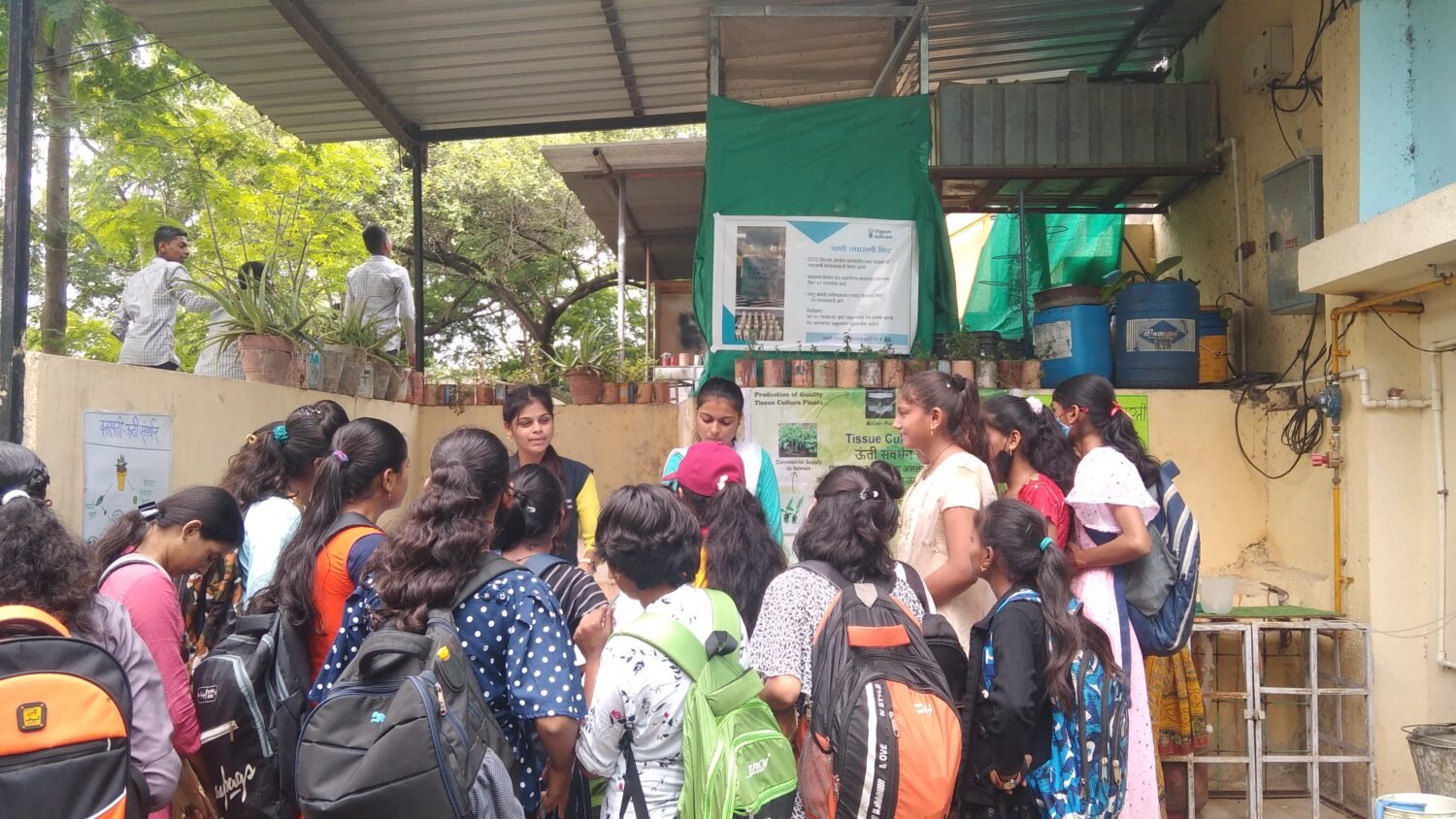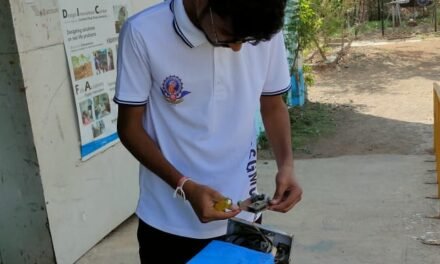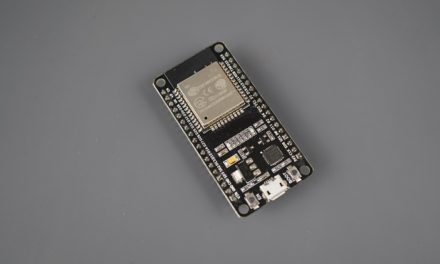Introduction
In Ashram many solar panels and solar-based systems are present. Nearly all single-phase requirement for electricity of the Ashram is fulfilled by solar energy. The information on all solar systems is available on this blog,
All solar panels in Ashram are working but that much amount of power is not needed for Ashram all the time. some of the panels are not in use. On the other hand, due to the rainy season and continuous clouds solar panels of the workshop system produce less energy, and sufficient charging of workshop batteries is not happening, due to insufficient charging, it discharges quickly and hamper the work of the workshop.
Date: 17/07/2023
We tried to use that extra energy or extra panels to charge the batteries of the workshop. We visited each solar system to check how many systems are working out of all systems. We observed that the solar system of water pump, which is installed at the back side of the polyhouse is not in use. The capacity of the solar water pump system is 1200 watts. We decided to connect the solar panels of water pump system to the workshop system in parallel, in parallel connection the output will increase and the voltage will remain same, but it is necessary to check that the voltage of both workshop and water pump solar panel array is the same. If increase the current input to the battery, the battery will charge quickly.
There is one problem, the distance between the workshop and the water pump system is more while transferring electricity current losses are more, and a higher gauge wire is needed.
Atharv, Uttara, and I told all things to Dixit sir. He said that if we want to minimize current losses then increase the voltage. The same thing is used in high voltage grid supply, to transfer electricity at long distances with minimum current losses.
Date: 18/07/2023
I visited the solar panels of both systems and collected all information.
| System | Solar panel | Batteries |
| Workshop system | 250W, 36 V, 10 Panels series connection: 5 Panels (36 V, 250 W) Output: 180 V, 1250 W. Parallel Connection: 2 arrays (180 V, 1250 W) Output: 180V, 2500 W. | 150 Ah, 12 V, 8 batteries Series: 8 Batteries (12 V, 150 Ah) Output: 96 V, 14,400 Wh |
| Water pump system | 300W, 36 V, 4 Panels Series connection: 4 panels (36 V, 300W) Output: 144 V, 1200W. | Not used |
Date: 19/07/2023
In the workshop system, one 5 KVA Hybrid inverter is used. A hybrid solar inverter is a piece of equipment that combines a solar inverter and a battery inverter into a single unit. This allows the hybrid solar inverter to intelligently handle the power coming from your solar panels, solar batteries and the utility grid. I searched the specification of that hybrid inverter on a blog, in-office (to check on a bill of the inverter) and on Google but I didn’t get much information. I started to search for information on Google,
What solar inverter?
A solar inverter is one of the most important parts of a solar power system. A solar inverter converts the output energy obtained from the solar panel into an appropriate form to use for home or workplace appliances
How does a solar inverter work?
A solar inverter works by taking in the variable direct current, or ‘DC’ output, from solar panels and transforming it into alternating 120V/240V current, or ‘AC’ output. The appliances in a home or in a workplace run on AC supply, not DC, so it is necessary to convert that DC current to AC current.
Types of solar Inverter systems.
there are three types of solar inverter systems.
- ON-grid solar system
- OFF-grid solar system.
- Hybrid solar system
1. ON-grid solar system
An on-grid system is also known as a grid-tied system. it is a system that works with the utility grid. when there is full sunshine it takes power from the solar panel and supplies it to the house and excess power available from panels goes to the utility grid. when clouds are present or+ at night time solar panels will not produce sufficient power at that time power is taken from the utility grid.

2. OFF-grid solar system.
An off-grid system is a system that is not dependent on the national electric grid. There are houses and communities that are far from the grid and it is not possible to connect with the national grid. In this case, the OFF grid option is suitable for these areas. It uses a battery to store exes energy and supply it whenever required.

3. Hybrid solar system
It combines the best approaches of both on-grid and off-grid systems. Energy from solar panels goes to house appliances, exes energy is utilized for charging of batteries and remaining energy is transferred to the grid. similarly, when solar panel doesn’t produce s energy, then energy available in batteries is utilized, and when charging of battery downs at that is takes energy from the grid supply.

In the workshop solar system of Vigyan Ashram hybrid solar system is used. The inverter available in the workshop is having single MPPT port.
What Is A MPPT?
MPPT stands for Maximum Power Point Tracker. It is a circuit available in the majority of modern photovoltaic inverters. Its function is to maximize the energy available from the connected solar module arrays at any time during its operation.
Why Is A MPPT Necessary?
A solar module is a limited energy DC supply and has internal impedances that vary throughout the course of the day, depending on the level of sun rays impinging on the module face and the cell temperature.
Dual MPPT port: Dual MPPT inverter is an inverter having two MPPT connections. The advantage of this inverter is that we can connect different numbers of solar panel arrays having different voltage outputs and located at different places with different angles. If the connections of one solar array breaks due to any reason then also system works properly on the connections of another solar panel array.
Date: 20/07/2023
I showed all information to Dixit sir. We decided to connect solar panels to the battery system of a workshop with an additional solar charge controller. I started to collect information about the charge controller.
These are the link from where I read about charge controller,
https://www.instructables.com/Solar-Battery-Charging/
https://www.renogy.com/blog/solar-charge-controller-sizing-and-how-to-choose-one-/.
https://energytheory.com/solar-charge-controller-load-output/
Date: 21/07/2023
Solar charge controller Calculations.
We have a 1200-watt solar module array of a water pump system that operates at 144 volts DC and our battery bank is 96 volts DC. MPPT charge controllers are rated by the output amperage that they can handle, not the input current from the solar module array. To determine the output current that the charge controller will have to handle we use the very basic formula for power in Watts:
Power = Volts x Amps
Here we know the power is 1200 Watts, the battery bank is 96 volts, so:
1200 Watts = 96 volts x Amps
which gives us:
Amps = 1200 Watts/ 96volts
Amps = 12.5A
We still want to adjust this value by 25% to take into account any special conditions that might cause the solar module array to produce more power than it is normally rated for So, 12.5A increased by 25% is 15.75A.
From the above calculation I selected,
| Particulars | Description |
| Solar Brand | UTL Solar |
| Technology | MPPT |
| SPV (Pmax) | 3kW-6kW |
| Charging Current | 30A |
| Efficiency Rate | >95% |
| Operating Range | 136V-352V |
| Switching Device | IGBT |
| Battery Nominal Voltage | 96V |
| Operation Temperature | 0°C to 50°C |
| Ingress Protection | IP-20 |
| Special Features | Dusk to Dawn / Parallel Load |
| Protections | Overcharging current, Overcharging voltage, SPV reverse polarity, Battery reverse polarity, Output short circuit, Overload & Reverse current flow at night. |
| Price ( Inclusive of all Taxes ) | Rs. 27,300.00 |

Here is the link of that charge controller,
https://www.upsinverter.com/utl/solar-charge-controller/96v-solar-charge-controller/





